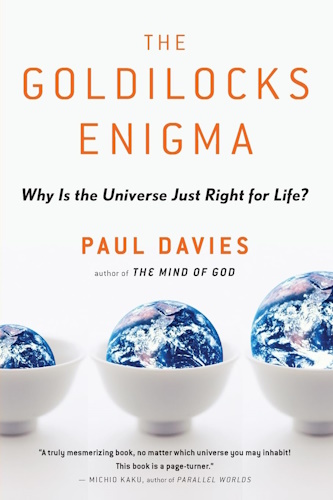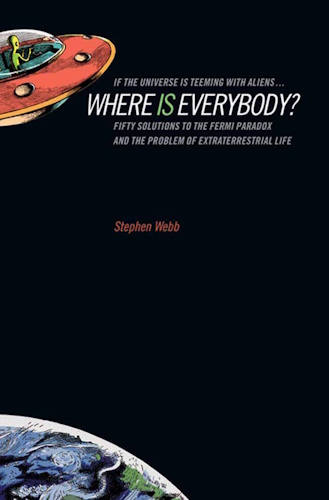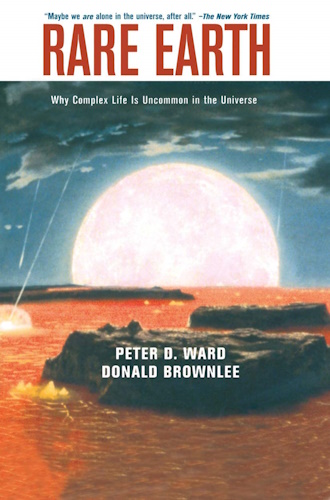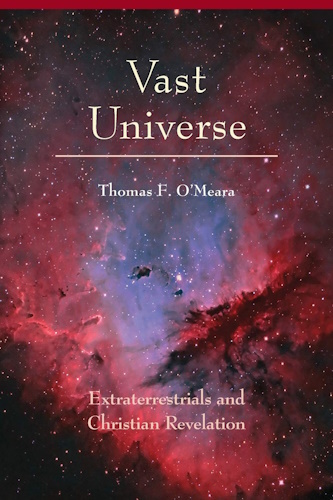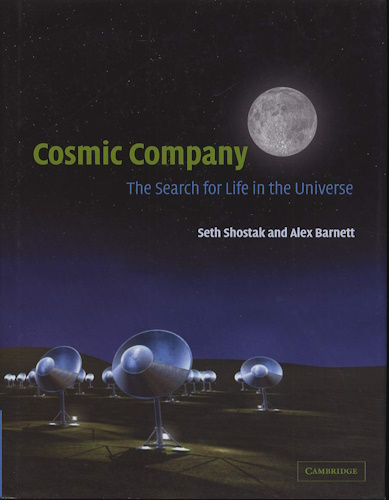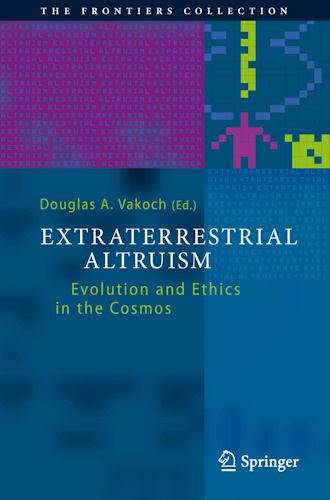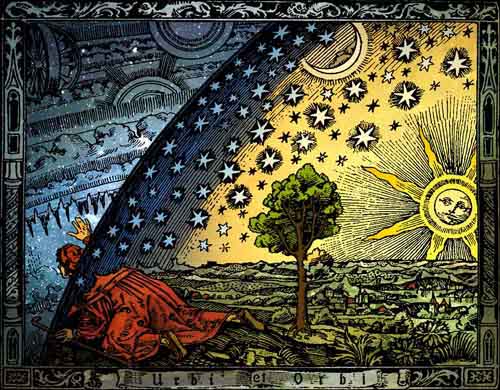![]()
Are We Alone?
by
Tim Dean
![]()
There could be more than 200 extraterrestrial civilizations humming away in our galaxy right now. Cosmos wonders where they are.
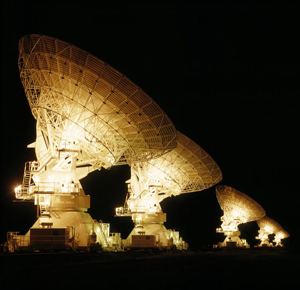
500 km north-west of Sydney, Australia.
Credit: ATCA/CSIRO
WHICH IS THE more shocking proposition: that our galactic neighbourhood is riddled with advanced alien civilisations? Or that we humans are a solitary beacon of intelligent life in a silent universe of almost incomprehensible vastness?
Either prospect is enough to keep you awake at night. Yet one of these two statements is likely true. We just don't know which one.
That's not to say we don't know anything about the likelihood of intelligent life existing in the universe. In fact, we know it does: the very presence of humanity means the probability of intelligence arising is greater than nil.
We just don't know how much greater than nil it is. It might be one in a million. It could be one in a billion. Or it could be a freak event, never to be repeated.
Consider the numbers involved: we live in a universe with billions upon billions of stars, many of which are very much like our own Sun, and each may well have a clutch of planets. So, even if the probability of intelligent life emerging is infinitesimally small, the sheer number of stars in the heavens makes it likely we're not alone.
One man who has maintained a life-long passion for solving this astronomical conundrum is Frank Drake, an American radio astronomer who now chairs the SETI Institute in the United States (SETI, a common acronym in the field, stands for Search for Extraterrestrial Intelligence).
According to Drake, his interest in the possible existence of extraterrestrial life started as a child. "I was eight years old and my father told me there were other worlds in space. To me that meant worlds with cities and people just like the Earth, and that fascinated me."
In the early 1960s, while working at the National Radio Astronomy Observatory in West Virginia, he and a few enthusiastic scientists became intrigued by the prospect of detecting evidence of extraterrestrial civilisations using the relatively new discipline of radio astronomy.
"In 1961, I was asked by the National Academy of Science to convene a meeting of scientists interested in SETI to explore what the possibilities were," says Drake.
"In preparing the agenda for the meeting, I listed all the factors one needed to know to predict the number of detectable civilisations in our galaxy. I recognised that if they were all multiplied together, one got an estimate of the number of detectable civilisations."
Thus the Drake equation was born. And it seems that ever since, Drake has spent his career in dogged pursuit of evidence for ET's existence.
While that evidence has yet to arrive, his equation lives on as a simple yet potent tool that gives us a road map of what we need to learn in order to solve this fundamental existential dilemma. So what's the equation like? Here it is:
N = R* x fp x ne x f1 x fi x fc x L
HOW MANY STARS?
The first term in the Drake equation, R*, refers to the yearly rate of star formation in our galaxy, and lays the foundation for the rest of the equation. Back in 1961, Frank Drake's original estimate of R* was 10 per year.
Stellar formation is one of the hot topics in astronomy right now, according to Rob Sharp, a Sydney based astronomer working for the Anglo-Australian Observatory. Sharp studies stellar formation in distant galaxies, which provides possible models for our own Milky Way in its infancy.
"The current 'best guess' working model has the Milky Way star formation rate at between one to 10 solar masses a year," he says. "This fits well with what's seen via all the different methods used to measure star formation in our own galaxy, and also with what's seen in other galaxies which are thought to be similar to our own Milky Way."
A study published in the British journal Nature in January 2006 makes a more specific estimate. Led by Roland Diehl of the Max Planck Institute for Extraterrestrial Physics in Germany, it looked at gamma waves emitted from exploding stars in stellar nurseries — the regions where stars are born. Gamma rays can penetrate the thick clouds of gas that are characteristic of these regions and which block our view in visible light.
The study concluded that stellar formation in the Milky Way was rolling along at a reasonable clip of seven solar masses per year. This doesn't necessarily mean that seven individual stars are formed each year, just that an amount of gas equal to around seven times the mass of our Sun collapses to form new stars in that time.
"Most new stars are very small, much smaller than the Sun," says Sharp. "More massive stars are very rare, and they don't live very long, only a few million years." This means that only a relatively small proportion of new stars — perhaps as low as two per cent — will be like our Sun. If that's the case, then the real value of R* could be anywhere between seven and 0.14.

HOW MANY PLANETS?
The next term in the Drake equation is fp, or the fraction of stars that have planetary systems. In 1961, astronomers were yet to find any evidence of extrasolar planets. But they did know that around half of all stars were binary systems, with two stars orbiting each other.
And at that time, scientists believed that binary systems were unlikely candidates for stable planetary systems. As a result, Drake's estimate for fp was a relatively straightforward 0.5. However, we no longer have to wildly speculate about the existence of planets outside our own Solar System.
One of the coolest discoveries in astronomy in the 20th century was — finally — the detection of extrasolar planets. There are now well over 200 known extrasolar planets, with more being detected each year, lending credence to the argument that many stars harbour planetary systems. But the question remains: what proportion of stars have planets?
Geoffrey Marcy, professor of astronomy at the University of California at Berkeley, is one of the leading experts on extrasolar planets. He and his team have spent the last two decades scrutinising nearby Sun-like stars looking for telltale signs of planetary systems. "Of the 2,000 nearby stars we are observing, about seven per cent have planets that we can detect," says Marcy. "But, the common occurrence of proto-planetary discs around young stars suggests that three quarters of them have planets, most of which are too small to detect."
As for fpaccording to Marcy's best guess, "the fraction of stars that have planets is probably about 70 per cent, plus or minus 10 per cent". That makes our value for fp 0.7 — a tad higher than Drake's estimate.
HOW MANY HABITABLE WORLDS?
Once we have an idea of the frequency of planetary systems, the next step is to determine how many planets in a solar system could potentially support life. This is represented by the term ne in the equation, and was originally estimated at two by Frank Drake.
When Drake made this estimate, the only model we had of a habitable planet was Earth, with Mars being an outside contender. These two planets lie within the 'continuously habitable zone', which is the area in space surrounding a star where the surface temperatures of any planet would be within the limits tolerable by life.
However, 'Earth-like' planets in the continuously habitable zone might not be the only candidates able to support life. According to Jeremy Bailey, associate director of the Australian Centre for Astrobiology at Sydney's Macquarie University, "there is an issue of how 'Earth-like' an Earth-like planet needs to be, and also whether life only occurs on Earth-like planets.
For example, possible locations for life in our own Solar System now include Europa and Enceladus, which are not Earth-like planets".
Europa and Enceladus are moons of Jupiter and Saturn respectively. Both of these moons show signs of sub-surface bodies of liquid water, heated by tidal compression caused by their proximity to their gaseous brethren. In light of the revelations surrounding exotic life discovered at deep ocean vents on Earth, there's reason to believe life could exist in similar conditions on either of these moons.
Given the uncertainty surrounding the likely constituents of extrasolar planetary systems, it's difficult to put an exact figure on ne.
All we know is that some systems might have one or more planets in the continuously habitable zone, as well as several moons that resemble Europa and Enceladus orbiting gas giants. As such, our estimate for ne lies somewhere between a conservative one and Drake's original estimate of two.

HOW MANY WORLDS HAVE LIFE?
With an idea of the number of planets (or moons) that could potentially support life, we can move on to the pressing question of how many actually do support life. This is represented by the term f1 in the Drake equation. Drake's original estimate was an optimistic 100 percent. This is based primarily on the fact that life sprung up on Earth relatively soon after its formation.
The argument goes that if life appeared so soon after the Earth formed, it seems reasonable to assume that the generation of life is not all that difficult to achieve, given appropriate conditions. Consequently, if there are other planets in our galaxy similar to the Earth, then it's likely, if not inevitable, that life will appear on them as well.
This argument is a popular one among scientists today. But the suggestion that the probability of biogenesis on any Earth-like planet is 100 per cent has recently been called into question by Australian astronomer and astrobiologist, Charles Lineweaver, a senior fellow at the Planetary Science Institute of the Australian National University in Canberra.
In a 2002 paper in U.S. journal Astrobiology, Lineweaver and colleague Tamara M. Davis argued that the figure is significantly lower. Drawing on our knowledge of biogenesis on Earth, they ran a probabilistic analysis of the chances of life occurring on an Earth-like planet elsewhere, and found it to be around 13 per cent (with a 95 per cent confidence level in their prediction). Which still means that it's likely life is out there.
However, Bailey of the Australian Centre for Astrobiology is not convinced. "There is still considerable controversy over the date of the earliest evidence of life, and on the early impact history of the Earth," he says. This would influence our understanding of the circumstances surrounding biogenesis, and how long it took for life to appear on Earth.
"There may be other possible explanations for life starting when it did. It could be because the bombardment of impactors [meteors and comets] provided some key component needed for life, such as organic molecules, or even brought in life itself from elsewhere," says Bailey.
To settle this point he thinks we need one of two things. "Either find a second sample of life elsewhere in the Solar System or beyond, such as on Mars, Europa, or on planets of nearby stars — it only needs to be microbial life, but we need to be able to show that it originated independently of life on Earth.
Two such occurrences close together would be convincing evidence that life forms relatively easily given the right conditions, and therefore that we live in a universe teeming with life," he says.
"The other way we could solve the problem is if we could come up with a convincing understanding of how life originated — perhaps even duplicating the process in the laboratory."
However, to date, scientists have yet to artificially create an organism from the basic building blocks of life. One individual working on the problem is Jack Szostak, professor of genetics and director of the Szostak Lab at the Harvard Medical School.
He believes one reason scientists may have been unsuccessful in replicating biogenesis in the lab is they're trying to synthesise the wrong type of organism. Most lab experiments to date have centred around DNA-based life, although Szostak thinks early life may have been based around the more fundamental RNA (ribonucleic acid).
Szostak is currently investigating what RNA-based life might be like and how it could have come about. "We're mainly looking at possible progenitors of RNA, and also at molecules that might more easily selfreplicate, so as to give us a useful model system," says Szostak. As for the prospects of Szostak creating an artificial organism, he's cautiously frank, and isn't putting a date on when he expects that feat to be achieved.
Ultimately, all we know is that life appeared here on Earth a few billion years ago, and that conditions on Earth are likely to be replicated to a greater or lesser extent on other terrestrial planets throughout our galaxy. As for f1, a probability of 1.0 seems unlikely. It's more feasible that it's somewhere between 0.5 and Lineweaver's 0.13.

HOW MANY HAVE INTELLIGENT LIFE?
This takes us to the next term in the Drake equation: fi, relating to the fraction of planets that evolve intelligent life. Frank Drake made a very conservative estimate of this number in 1961, suggesting that just one per cent of planets with life ever evolve intelligence.
As with questions about the genesis of life from nonlife, we have but a single paragon example of intelligent life: us. This indicates that the probability of intelligence arising is greater than zero, but there's fierce contention over how much greater than zero that number is. "Although we understand the process of= evolution in one sense, it is not clear that we can predict how evolution will unfold in the future, or on other planets," says Bailey.
There are currently two main models, and they offer different predictions about the likelihood of intelligence evolving. The first was promoted by renowned U.S. palaeontologist, the late Stephen Jay Gould.
He suggested that evolution is primarily guided by chance. That means two planets with similar initial conditions could have wildly different evolutionary histories. According to Bailey, if this is true, "we would expect life on other planets to be completely different from life on Earth, and it is highly unlikely that it would result in anything like humans."
The other model is proposed by Simon Conway Morris, a palaeobiologist at the University of Cambridge who suggests that 'convergence' is a dominant guiding force in evolution. This is the belief that evolution naturally selects towards a relatively small set of solutions to common problems.
Examples are stereoscopic vision, wings and protective spines, all of which have independently evolved in a wide range of species. The question is whether intelligence is one of these convergent solutions and therefore likely — or even certain — to arise given sufficient time.
Bailey is not sold on the idea. "It seems to me convergence only shows up in the detail, rather than in the large scale," he says. "I can't agree with Conway Morris that humans, and hence intelligence, are inevitable."
One way to test the hypothesis that intelligence is likely to evolve is to examine cases in which it has done so compared with those where it has failed to arise. British cosmologist Paul Davies is director of BEYOND,
a new 'cosmic think tank' at Arizona State University, and author of The Goldilocks Enigma: Why Is The Universe Just Right For Life?
He suggests this 'experiment' has already taken place several times on Earth, due to the fact that the continents have been isolated from each other. "Intelligence evolved on only one [Africa], so the odds would have to be less than about one in five," says Davies. "Also, intelligence took a long time to evolve. Why didn't it happen 200 million years ago? That suggests to me it is a big, hard step." So even if intelligence is possible or likely, we don't know how long it would take to pop up.
That leads Davies to estimate the odds of intelligence arising at being "no greater than one in a million, per 100 million years of benign environment". That would put our figure of fi, somewhere between Drake's original 0.01 and a slightly more optimistic 0.025.

HOW MANY CIVILISATIONS ARE DETECTABLE?
An intelligent civilisation may well arise, but if we can't detect it, we'll never know it's there.
Frank Drake was interested in using radio astronomy to detect extraterrestrial civilisations, so his original formulation of the equation factored in the likelihood they would communicate in ways we could detect, represented by fc, which he estimated at 0.01.
Back in the 1960s it was widely believed that radio would be the communications technology of choice for an advanced civilisation, whether through deliberate broadcasts into space, or leakage of terrestrial communications. In fact, our own planet has been telegraphing evidence of our technological civilisation for over 70 years.
There are hundreds of stars within 70 light-years of our Solar System that could harbour life, and they could be tuning in to everything from I Love Lucy to Skippy the Bush Kangaroo even as you read this.
Much has been written about the possibility of detecting a civilisation by radio, including the most likely frequencies to tune in to and the relative strength of signals required to penetrate the natural interference permeating the 'noisy' voids of space.
However, before we point our radio dishes to the sky, we need to consider whether other intelligent civilisations would even use radio to communicate.
Perhaps it has been long superseded? We have only been using radio for less than a century — a moment in cosmic time — and there may be superior forms of communication just over the horizon (pardon the pun) that don't result in significant signal leakage into space.
Just because we use it doesn't mean it's still in fashion: after all, we've only just stumbled out of the caves in the last 100,000 years.
What's radio to a civilisation that's had technology for 100,000 years? There's also the possibility that an alien civilisation would deliberately mask its presence from its neighbours.
"You can certainly make a case that at least some other civilisations are likely to be hostile towards us, therefore betraying our existence may not be a smart thing to do," says Bailey. "Other civilisations, if they are there, may have come to the same conclusion."
Paul Davies makes a similarly pessimistic estimation of the number of detectable civilisations, at "no more than one in a thousand". That would place our value of fc, somewhere between Drake's original value of 0.01 and Davies' estimate of 0.001.

HOW LONG DO THEY LAST?
The final term in the Drake equation, L, refers to the average lifetime of a civilisation advanced enough to be detectable.
We know an intelligent species can survive for well over 100,000 years, as Homo sapiens has already managed. However, humans have only had civilisation for around 10,000 years, and we've been detectable for less than a century.
The author of the equation himself is worried that an advanced civilisation might not be detectable for long.
"The main sign of our existence is our classical television broadcasts. They may soon fade away as we switch to the use of cable and satellite transmissions of TV to homes," says Drake. "So we, like many civilisations, may be easily detected for only a short time — even though we continue to thrive for perhaps millions or billions of years more."
Then there's the question of whether an intelligent species can survive an industrial and technological revolution. It may be the case that the development of technology advanced enough to make a civilisation detectable also coincides with the development of technology that could wipe it out in a holocaust — such as war, climate change or runaway nanotechnology, to name a few.
According to Davies, "the statistics will be totally skewed by the few [civilisations] that make it through the bottleneck we are currently experiencing, into the post-industrial, post-religious age". This means as many as nine out of every 10 civilisations might die off within 200 years. On the other hand, one in 10 might make it through to the other side and survive for thousands of years.
"A combination of genetic engineering and artificial intelligence will create a society with essentially infinite longevity," says Davies. "So the history of intelligence in the universe will be completely dominated by a handful of survivor civilisations."
If, then, one in ten civilisations lasts for 100,000 years, that would make our estimate for L 10,000 years which, interestingly enough, corresponds to Drake's original estimate from 1961. A more optimistic estimation — where at least a few civilisations last for millions of years — could place L at 200,000.
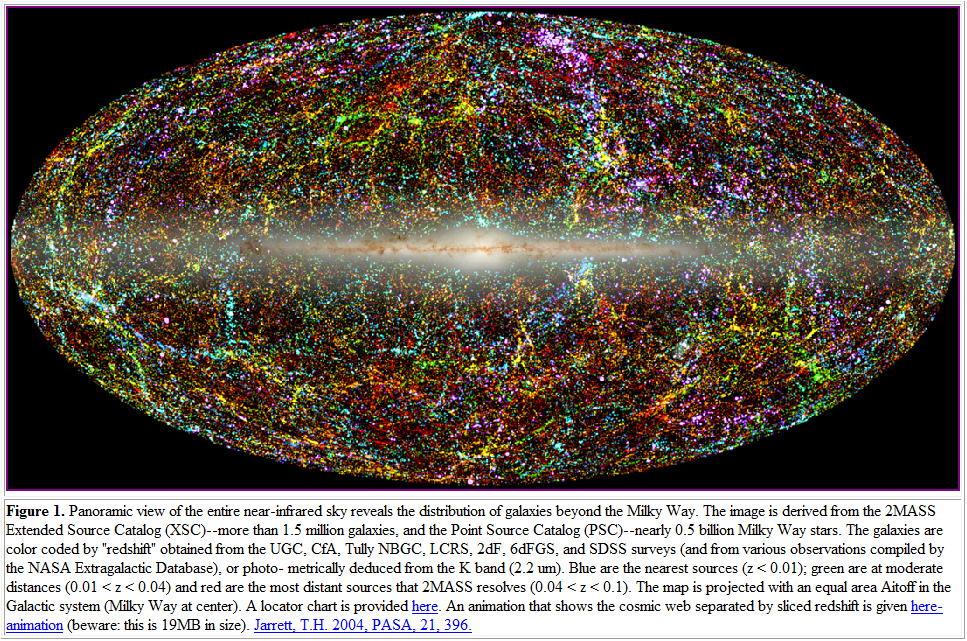
THE ANSWER?
Now that we have all the terms of the Drake equation in hand, we can make our estimates for N — the number of detectable extraterrestrial civilisations that are out there in our galaxy, right now. Drake's original calculations placed N between four and ten.
However, we've revised many of Drake's 1961 estimates using the latest scientific knowledge. If we punch all of our most conservative estimates into the Drake equation, including our very low estimates of Sun-like star formation and the fraction of planets that have life, we arrive at a new figure for N of 0.00127.
To put that in perspective, it means that over a 100,000-year period, around 127 detectable civilisations will crop up but they may not overlap. That makes the odds of us tracking one of them down, especially within only a few hundred years of looking, minimal at best.
Our more optimistic estimation is a little more encouraging, with N equalling 245. Even so, the galaxy is a big place, and there's no telling where an extraterrestrial civilisation might appear. How do our experts feel about these numbers?
On the whole, they're cautiously pessimistic. Bailey is sceptical of the notion that detectable civilisations exist. "But there is certainly a reasonable possibility that
other intelligent life exists," he says.
Lineweaver, who gave us our probabilistic analysis of the genesis of life on Earth, is also erring on the side of caution. "My reading of the evidence we do have is that, no, they don't exist." Marcy, the leading expert on extrasolar planets, is hopeful that intelligent life might be out there, but he's not so sure how long it will last. "I am desperately worried that L may be only a few thousand years, making intelligent life rare in the Milky Way."
Despite this wave of pessimism, a glimmer of hope remains in the hearts of some scientists. Take Davies: "I hope we are not alone. I would find that a depressing prospect," he says. "But the truth is, we simply don't know." Or Drake himself, who also maintains his optimism. "I have a strong conviction that extraterrestrial intelligence or civilizations exist in our galaxy today. Many of them."
A CACOPHONY OF SILENCE
Even if we accept a low estimate for N, it seems reasonable that there should have been enough civilisations in our galactic history to leave some kind of evidence of their passing.
Remember, radio waves propagate at the speed of light, so we could theoretically detect the presence of a civilisation that lived half way across the galaxy and died out thousands of years ago. There's also the likelihood that a few civilisations will last for many millions of years, so surely they'd still be kicking around.
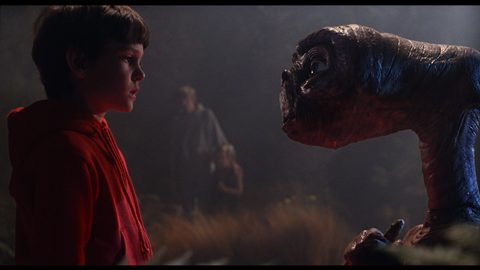
SO, WHY THE SILENCE?
This very question was posed in 1950 by the famous Italian physicist, Enrico Fermi, during a discussion with his colleagues. Thus, over 10 years before the formulation of the Drake equation, we already had a sceptical position, now known as the Fermi paradox.
Stephen Webb, author of If the Universe Is Teeming with Aliens ... WHERE IS EVERYBODY?: Fifty Solutions to the Fermi Paradox and the Problem of Extraterrestrial Life, has a fairly straightforward explanation for the lack of contact. "Perhaps the most likely reason we haven't heard from them is that they don't exist!"
But there are other reasons that might explain why we haven't detected extrasolar civilisations. "The universe is big. If they all have a level of technology that is not too far in advance of our own then they would find — as we do — that sending a signal that can be detected by the rest of the galaxy is extremely difficult," says Webb. "It would not be surprising that we haven't yet detected a signal."
Then there are the more esoteric explanations as to why evidence remains scarce, such as the planetarium hypothesis. "This is the rather solipsistic notion that we're living in a simulation provided for us by an extraterrestrial civilisation," explains Webb. "We don't see or hear from them because they've engineered the simulation so that we don't see or hear from them."
Another alternative is the Berserker hypothesis. According to this view "the first civilisation to reach space-faring capabilities has sent out probes to snuff out any emerging, and thus potentially competitor,
lifeforms."
This thesis is a variation on the idea of 'von Neumann probes', inspired by the work done by Hungarian physicist John von Neumann on self-replicating machines. He proposed that an alien civilisation might unleash automated probes to explore space; these probes could arrive at a distant solar system, harvest the resources found there to create new probes, and send them on to new systems.
However, reason suggests that a few von Neumann probes, replicating exponentially, might only take a few million years to explore our entire galaxy. As such, their conspicuous absence could be seen as evidence for a lack of other advanced alien civilisations in the Milky Way.
Another reason we might not have detected alien intelligence is, of course, that we really are alone. Donald Brownlee, a professor of astronomy at the University of Washington in Seattle, is co-author of the book Rare Earth: Why Complex Life is Uncommon in the Universe and is inclined to think Earth-like planets that can support life are not as common as the Drake equation might suggest.
"We have no evidence that the Earth is unique, but we do have evidence that the Earth is rare", says Brownlee. One example is the presence of our unusual Moon. No other inner rocky planets in our Solar System have moons even approaching the scale of ours.
Yet the existence of this idiosyncratic satellite may have contributed to stabilising the Earth's tilt and rotation, thus contributing to our relatively mild seasons and calm weather patterns, as well as to tides and plate tectonics.
The Earth also has just the right kind of chemical composition and metallic core to generate a powerful magnetic field, which protects the biosphere from potentially lethal cosmic radiation from space. It's possible these and other features played a role in the origins of life or the maintenance of an environment suitable for the evolution of intelligence.
If that's the case, then other Earth-like planets without the very same combination of features — an oversized satellite, molten core and plate tectonics — may end up barren of life altogether. Like Mars.
Brownlee is still hopeful that intelligent life could exist elsewhere in our galaxy, but it would be so uncommon that we'd have little chance of detecting it. "If civilisations are rare enough, then they will be so far apart that they will be forever isolated from each other," he says.
Whether you accept the conclusions of the Drake equation, and see us living in a galaxy populated by dozens, or even hundreds, of advanced alien civilisations, or whether you think life on Earth is a freak occurrence, never to be repeated throughout the universe, the implications are staggering.
Perhaps the most intriguing fact in this whole discussion is that there is an answer to whether or not we're alone: either we are but a single mote of intelligence in this expansive universe, or we are just one voice in a vast galactic chorus.
And as long as there's no evidence to the contrary, there'll always be a glimmer of hope that we might, one day, hear that faint beckoning call, reassuring us that we are truly not alone.
Tim Dean is a science writer in Sydney and a former Editor of Cosmos. Given the numbers involved, he'd be staggered if life wasn't out there.
![]()
![]()
Disclaimer:
Some material presented will contain links, quotes, ideologies, etc., the contents of which should be understood to first, in their whole, reflect the views or opinions of their editors, and second, are used in my personal research as "fair use" sources only, and not espousement one way or the other. Researching for 'truth' leads one all over the place...a piece here, a piece there. As a researcher, I hunt, gather and disassemble resources, trying to put all the pieces into a coherent and logical whole. I encourage you to do the same. And please remember, these pages are only my effort to collect all the pieces I can find and see if they properly fit into the 'reality aggregate'.
Personal Position:
I've come to realize that 'truth' boils down to what we 'believe' the facts we've gathered point to. We only 'know' what we've 'experienced' firsthand. Everything else - what we read, what we watch, what we hear - is what someone else's gathered facts point to and 'they' 'believe' is 'truth', so that 'truth' seems to change in direct proportion to newly gathered facts divided by applied plausibility. Though I believe there is 'truth', until someone representing the celestial realm visibly appears and presents the heavenly records of Facts And Lies In The Order They Happened, I can't know for sure exactly what "the whole truth' on any given subject is, and what applies to me applies to everyone. Until then I'll continue to ask, "what does The Urantia Book say on the subject?"
~Gail Bird Allen
![]()
![]()

